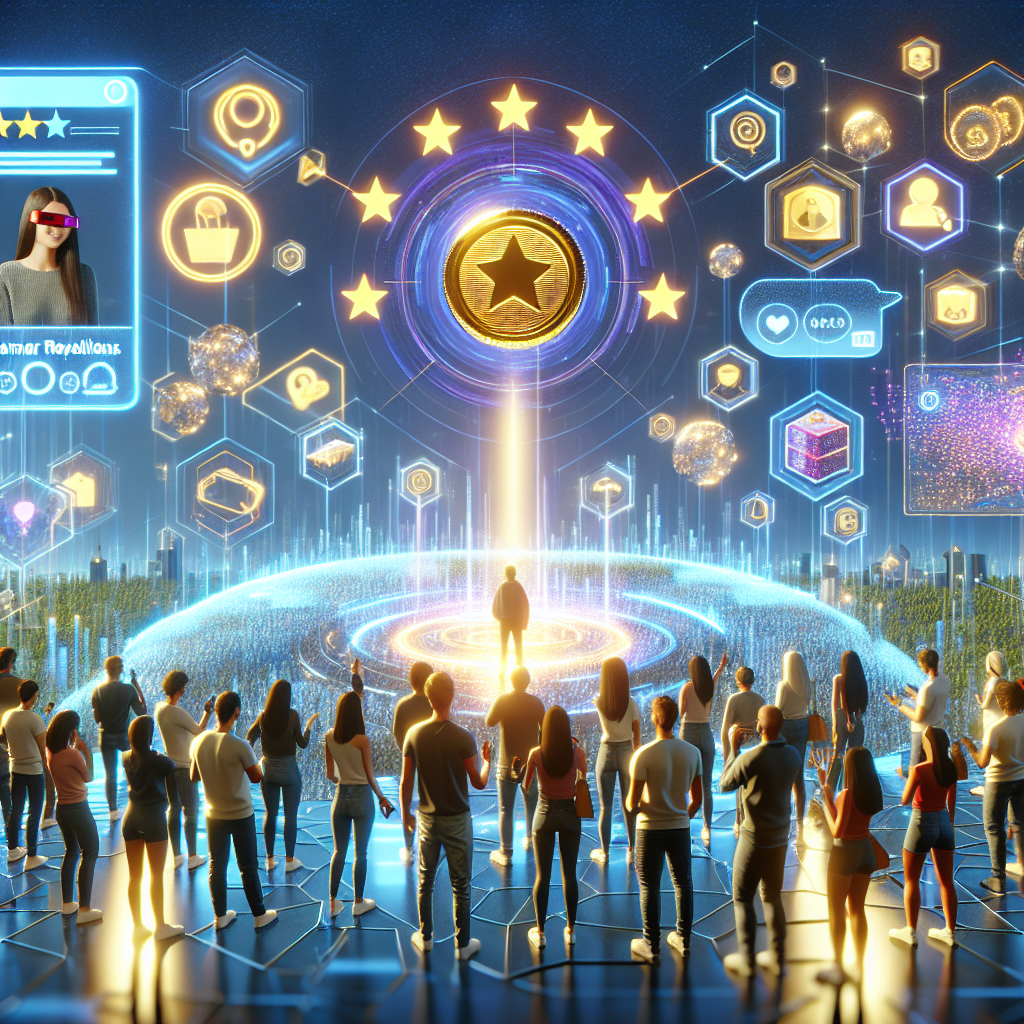
Personalization: How to Tailor Your Digital Strategy to Meet Individual Customer Needs
In today’s digital age, building customer loyalty has become more important than ever. With the rise of e-commerce and social media, customers have more options and information at their fingertips, making it easier for them to switch brands if they are not satisfied. This is why personalization has become a crucial aspect of any successful digital strategy. By tailoring your approach to meet individual customer needs, you can create a strong bond with your customers and keep them coming back for more.
The first step in personalizing your digital strategy is to understand your customers. This means gathering data and insights about their preferences, behaviors, and needs. With the help of analytics tools, you can track customer interactions on your website, social media platforms, and email campaigns. This data can provide valuable insights into what your customers are looking for and how they engage with your brand.
Once you have a better understanding of your customers, you can start tailoring your digital strategy to meet their individual needs. One effective way to do this is by creating personalized content. This can include product recommendations based on their previous purchases, personalized emails addressing them by name, or even personalized landing pages on your website. By providing relevant and personalized content, you can make your customers feel valued and understood, which can lead to increased loyalty.
Another important aspect of personalization is communication. In today’s digital world, customers expect a seamless and personalized experience across all channels. This means that your communication with them should be consistent and tailored to their preferences. For example, if a customer prefers to be contacted via email, make sure to send them updates and promotions through that channel. If they prefer social media, engage with them on those platforms. By understanding their preferred communication channels, you can build a stronger connection with your customers.
In addition to personalized content and communication, offering personalized promotions and rewards can also be an effective way to build customer loyalty. This can include personalized discounts, freebies, or loyalty programs tailored to individual customer needs. For example, if a customer frequently purchases a specific product, you can offer them a discount on their next purchase of that product. This not only makes them feel appreciated but also encourages them to continue buying from your brand.
Moreover, personalization can also extend to the customer service experience. With the rise of chatbots and AI technology, it has become easier to provide personalized customer service. By using customer data and insights, chatbots can provide tailored responses and solutions to customer inquiries. This can save time for both the customer and your business, leading to a more positive and efficient customer service experience.
Lastly, it is important to continuously gather feedback from your customers and use it to improve your personalization efforts. This can be done through surveys, reviews, or even social media polls. By listening to your customers and implementing their suggestions, you can show them that their opinions are valued and that you are committed to providing them with the best experience possible.
In conclusion, personalization is a crucial aspect of building customer loyalty in the digital age. By understanding your customers, tailoring your content and communication, offering personalized promotions, and continuously gathering feedback, you can create a strong bond with your customers and keep them coming back for more. Remember, in today’s competitive market, personalization is not just a strategy, it is a necessity. So, make sure to incorporate it into your digital strategy and watch your customer loyalty grow.
The Power of Social Media: Leveraging Online Platforms to Connect and Engage with Customers
In today’s digital age, social media has become an integral part of our daily lives. From connecting with friends and family to staying updated on current events, social media has transformed the way we communicate and interact with the world. But beyond personal use, social media has also become a powerful tool for businesses to connect and engage with their customers. In this section, we will explore the power of social media and how businesses can leverage online platforms to build customer loyalty.
One of the biggest advantages of social media is its ability to reach a large audience. With billions of active users on various platforms, businesses have the opportunity to connect with a vast pool of potential customers. This makes social media an essential tool for building brand awareness and reaching out to new customers. By creating a strong online presence, businesses can increase their visibility and attract new customers to their products or services.
But beyond just reaching a large audience, social media also allows businesses to engage with their customers in a more personal and interactive way. Through platforms like Facebook, Twitter, and Instagram, businesses can have direct conversations with their customers, respond to their queries and feedback, and even showcase their products or services through visual content. This level of engagement helps to build a stronger connection with customers and creates a sense of trust and loyalty towards the brand.
Another advantage of social media is its cost-effectiveness. Unlike traditional marketing methods, social media allows businesses to reach a large audience at a fraction of the cost. This makes it an ideal platform for small businesses or startups with limited marketing budgets. By creating engaging and shareable content, businesses can increase their reach and attract new customers without breaking the bank.
One of the key strategies for building customer loyalty through social media is consistency. It is essential to maintain a consistent brand image and voice across all social media platforms. This helps to create a sense of familiarity and trust among customers. By consistently posting relevant and engaging content, businesses can keep their customers interested and connected to their brand.
Another important aspect of leveraging social media for customer loyalty is to listen and respond to customer feedback. Social media provides a platform for customers to voice their opinions and share their experiences with a brand. By actively listening and responding to this feedback, businesses can show their customers that their opinions are valued and that their satisfaction is a top priority. This not only helps to build a positive brand image but also creates a sense of loyalty among customers.
In addition to engaging with customers, social media also allows businesses to reward their loyal customers. By offering exclusive discounts, promotions, or rewards to their social media followers, businesses can show their appreciation and incentivize customers to continue supporting their brand. This not only helps to retain existing customers but also attracts new ones through word-of-mouth recommendations.
Lastly, businesses can also use social media to showcase their brand values and connect with customers on a deeper level. By sharing behind-the-scenes content, highlighting their corporate social responsibility efforts, or showcasing their company culture, businesses can create a more personal and relatable image for their brand. This helps to build an emotional connection with customers, which can lead to long-term loyalty and advocacy for the brand.
In conclusion, social media has become a powerful tool for businesses to connect and engage with their customers. By leveraging online platforms, businesses can reach a large audience, engage with customers in a personal and interactive way, and showcase their brand values. By implementing these strategies, businesses can build strong customer loyalty in the digital age and create a loyal customer base that will support their brand for years to come.
Creating a Seamless Customer Experience: Integrating Digital Channels for a Cohesive Brand Image
In today’s digital age, businesses are constantly looking for ways to stand out and build a loyal customer base. With the rise of e-commerce and social media, customers have more options than ever before, making it crucial for businesses to create a seamless customer experience across all digital channels. This not only helps to attract new customers but also fosters loyalty among existing ones. In this article, we will discuss some strategies for building customer loyalty in a digital age by integrating digital channels for a cohesive brand image.
The first step in creating a seamless customer experience is to have a strong online presence. This includes having a user-friendly and visually appealing website, active social media accounts, and a presence on relevant online platforms. Customers today expect to find businesses online, and a well-designed website can make a great first impression. It should be easy to navigate, have clear and concise information, and provide a seamless shopping experience. Social media is also a powerful tool for businesses to connect with their customers and showcase their brand’s personality. By regularly posting engaging content and responding to customer inquiries, businesses can build a strong online presence and establish a personal connection with their customers.
Another important aspect of creating a seamless customer experience is to ensure consistency across all digital channels. This means that the brand’s messaging, visuals, and tone should be consistent across the website, social media, and any other online platforms. Inconsistency can confuse customers and make them question the credibility of the brand. By maintaining a cohesive brand image, businesses can build trust and loyalty among their customers.
Personalization is also key in building customer loyalty in a digital age. With the abundance of data available, businesses can use it to their advantage by tailoring their marketing efforts to individual customers. This can be done through targeted email campaigns, personalized product recommendations, and customized promotions. By showing customers that their preferences and needs are understood and valued, businesses can create a more personalized and meaningful experience, leading to increased customer loyalty.
Integrating digital channels also means providing a seamless omnichannel experience for customers. This means that customers should be able to seamlessly transition from one channel to another without any disruptions. For example, a customer should be able to browse products on a brand’s website and then easily make a purchase through their mobile app. This not only makes the shopping experience more convenient for customers but also helps to create a cohesive brand image.
In addition to providing a seamless experience, businesses should also focus on creating a positive and memorable customer experience. This can be achieved through exceptional customer service, personalized interactions, and going above and beyond to exceed customer expectations. In a digital age where customers have endless options, providing a positive experience can make all the difference in building customer loyalty.
Lastly, businesses should continuously gather feedback and use it to improve their digital channels and overall customer experience. This can be done through surveys, social media polls, and monitoring online reviews. By listening to customer feedback and making necessary improvements, businesses can show their customers that their opinions are valued and that their satisfaction is a top priority.
In conclusion, building customer loyalty in a digital age requires businesses to create a seamless customer experience by integrating digital channels for a cohesive brand image. This includes having a strong online presence, maintaining consistency, personalization, providing a seamless omnichannel experience, creating a positive customer experience, and continuously gathering feedback. By implementing these strategies, businesses can not only attract new customers but also foster loyalty among existing ones, leading to long-term success in the digital world.
Rewarding Loyalty: Implementing Effective Digital Loyalty Programs to Retain Customers
In today’s digital age, building customer loyalty has become more important than ever. With the rise of e-commerce and online shopping, customers have endless options at their fingertips, making it crucial for businesses to find ways to retain their loyal customers. One effective strategy for building customer loyalty in the digital age is through implementing digital loyalty programs.
Digital loyalty programs are a modern twist on traditional loyalty programs, where customers earn rewards for their continued patronage. These programs utilize technology to track and reward customer behavior, making it easier for businesses to understand their customers’ preferences and tailor their rewards accordingly.
One of the main benefits of digital loyalty programs is the ability to collect valuable customer data. By tracking customer behavior, businesses can gain insights into their customers’ shopping habits, preferences, and interests. This data can then be used to create personalized rewards and offers, making customers feel valued and appreciated.
Moreover, digital loyalty programs offer convenience for both businesses and customers. With traditional loyalty programs, customers often have to carry physical cards or remember their membership numbers. With digital programs, customers can simply use their phone number or email address to access their rewards, making it more convenient and hassle-free.
Another advantage of digital loyalty programs is the ability to reach a wider audience. With the rise of social media and online marketing, businesses can easily promote their loyalty programs and attract new customers. By offering enticing rewards and incentives, businesses can entice potential customers to join their loyalty program and become loyal customers.
When implementing a digital loyalty program, it is essential to make the rewards and incentives attractive and relevant to your target audience. For example, if your business caters to a younger demographic, offering discounts on popular products or exclusive access to events or experiences may be more appealing than traditional points-based rewards.
Additionally, businesses should make it easy for customers to redeem their rewards. With digital programs, customers can easily track their rewards and redeem them through their preferred method, whether it be online or in-store. This convenience can further enhance the customer experience and encourage them to continue patronizing the business.
Furthermore, businesses should regularly communicate with their customers through their loyalty program. This can be done through email or push notifications, informing customers of new rewards, promotions, or exclusive offers. By keeping customers engaged and informed, businesses can strengthen their relationship with their customers and increase their loyalty.
It is also crucial for businesses to continuously evaluate and improve their digital loyalty programs. By analyzing customer data and feedback, businesses can identify areas for improvement and make necessary changes to keep their loyalty program relevant and effective. This can include updating rewards, adding new features, or incorporating gamification elements to make the program more engaging.
In conclusion, digital loyalty programs are a valuable tool for businesses to build and maintain customer loyalty in the digital age. By utilizing technology, businesses can collect valuable customer data, offer convenience, reach a wider audience, and personalize rewards to keep customers engaged and loyal. However, it is essential to continuously evaluate and improve these programs to ensure their effectiveness and relevance. With the right strategies and implementation, digital loyalty programs can be a powerful tool for businesses to retain their customers and thrive in the competitive digital landscape.
Data-Driven Insights: Utilizing Customer Data to Improve and Adapt Your Digital Loyalty Strategy
In today’s digital age, building customer loyalty has become more important than ever. With the rise of e-commerce and online shopping, customers have endless options at their fingertips, making it crucial for businesses to find ways to stand out and retain their customers. One effective way to do this is by utilizing customer data to improve and adapt your digital loyalty strategy.
Data-driven insights have become a valuable tool for businesses looking to understand their customers better. By collecting and analyzing customer data, businesses can gain valuable insights into their customers’ behaviors, preferences, and needs. This information can then be used to tailor their digital loyalty strategy to meet the specific needs and wants of their customers.
One of the most significant benefits of utilizing customer data is the ability to personalize the customer experience. With the vast amount of data available, businesses can create targeted and personalized marketing campaigns that speak directly to their customers. By understanding their customers’ preferences and behaviors, businesses can send relevant and timely offers and promotions, increasing the chances of customer engagement and loyalty.
Moreover, customer data can also help businesses identify their most loyal customers. By analyzing purchase history and engagement levels, businesses can identify their most valuable customers and reward them accordingly. This not only helps to strengthen the relationship with these customers but also encourages them to continue their loyalty to the brand.
Another way to utilize customer data is by using it to improve the overall customer experience. By analyzing data from customer feedback and reviews, businesses can identify areas for improvement and make necessary changes to enhance the customer experience. This could include improving website navigation, streamlining the checkout process, or offering more personalized product recommendations. By continuously improving the customer experience, businesses can build trust and loyalty with their customers.
In addition to personalization and customer experience, data-driven insights can also help businesses stay ahead of trends and adapt their loyalty strategy accordingly. By analyzing customer data, businesses can identify emerging trends and preferences, allowing them to adjust their loyalty program to meet these changing needs. This not only keeps the loyalty program relevant but also shows customers that the business is paying attention to their wants and needs.
Furthermore, customer data can also be used to track the success of a loyalty program. By setting specific metrics and tracking customer data, businesses can measure the effectiveness of their loyalty program and make necessary adjustments. This could include tracking customer retention rates, engagement levels, and overall sales. By regularly monitoring these metrics, businesses can ensure that their loyalty program is achieving its intended goals and make changes if needed.
However, it is essential to note that with the use of customer data comes the responsibility to protect it. Businesses must ensure that they are following all data privacy laws and regulations and have proper security measures in place to protect their customers’ data. This not only builds trust with customers but also avoids any potential legal issues.
In conclusion, utilizing customer data to improve and adapt your digital loyalty strategy is crucial in today’s digital age. By personalizing the customer experience, identifying loyal customers, improving the overall customer experience, staying ahead of trends, and tracking the success of the loyalty program, businesses can build strong and lasting relationships with their customers. However, it is essential to handle customer data with care and responsibility to maintain trust and avoid any potential issues. With the right data-driven insights, businesses can create a successful and effective digital loyalty strategy that will keep customers coming back for more.
We have lots of exciting coming events in Entrepreneurship, Investing and Personal Development. You can find them all here:
www.swedishwealthinstitute.se/events




